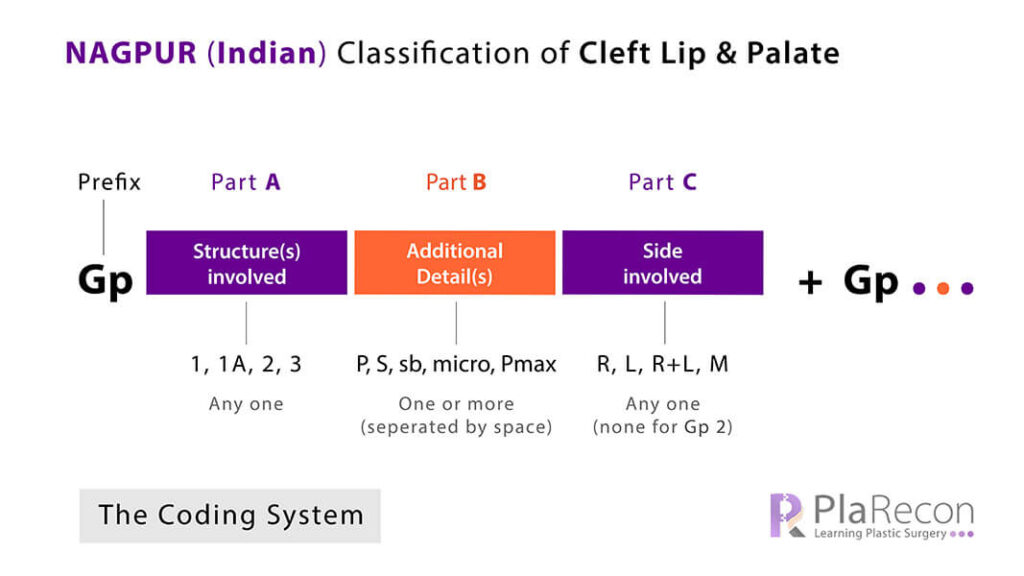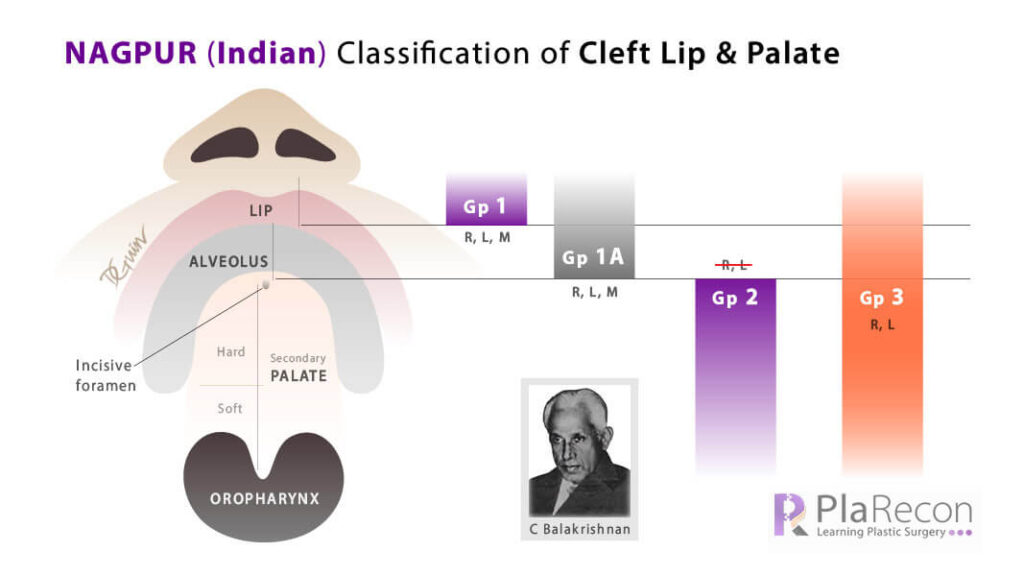Though there are a myriad of cleft lip (CL) and cleft palate (CP) classifications, very few are embryologically and clinically as sound as the simple Nagpur classification or the Indian classification of cleft lip and palate, described by Prof. Chakkiri Balakrishnan (aka, ‘CBK’), referred to as the Father of Modern Plastic Surgery in India.
Initially, Prof. C Balakrishnan (1975) had classified cleft lip and palate into 3 groups (1– lip, 2-palate, 3-lip and palate) and given abbreviations ‘A’ for Alveolar involvement and ‘R, L, M’ for Right, Left and Median and each component of combinations were separated by ‘/’. It was a more logical version of the Davis and Ritchie (1922) or Dahl (1970) classifications and was based on the Kernahan and Stark (1958) classification (anatomical).
Over time, other abbreviations: P, S, sb, micro and Pmax (details in the table below) got incorporated and the modified classification was described by Agrawal K in 20143 (also, each component of the code combinations were now separated by ‘+’ instead of the original ‘/’.)
Nagpur Classification details
| GROUPS | Based on the Structure(s) involved [Prof CBK, 1975] |
|---|---|
| 1 | Cleft Lip |
| 1A | Cleft Lip + Alveolus [includes primary palate- anterior to incisive foramen] |
| 2 | Cleft Palate [posterior to incisive foramen i.e. secondary palate] |
| 3 | Cleft Lip [+ Alveolus] and Palate |
| ABBREVIATIONS | |
| — Based on the Side: | [as described by Prof CBK] |
| R | Right |
| L | Left |
| R+L | Bilateral |
| M | Midline |
| — Based on Additional details: | [as subsequently added- Karoon Agrawal, 2014] |
| P | Partial |
| S | Submucous cleft of palate |
| sb | simonart's band |
| micro | microform |
| Pmax | Protruding premaxilla |
How is it written or applied?
The classification is expressed in 3 parts using abbreviations- as described in the image below, with a prefix- Gp for Group.

Salient points to note:
- Gp2 (i.e. secondary/posterior palatal cleft) does not have part C, i.e. the ‘Side’ component in this classification.
- Pmax (protruding premaxilla) is associated with bilateral clefts, i.e. with Gp1 Pmax R+L and Gp3 Pmax R+L.
Examples
- Complete cleft lip on the left side with no alveolar involvement: Gp 1 L
- Partial cleft lip on the right side with submucous cleft palate: Gp 1P R + Gp 2S
- Bilateral complete cleft lip with alveolar and primary palate involvement and with protruding premaxilla: Gp 1A Pmax R+L
- Midline partial cleft lip with complete cleft palate and intact primary (anterior) palate and alveolus: Gp 1P M + Gp 2
- Complete cleft lip, alveolus and palate on the left side with Simonart’s band: Gp 3 sb L
6 reasons why Nagpur Classification is so Popular?
Nagpur classification is the single most popular classification for cleft lip and palate in India. Over the last ~5 decades, it stood the test of time and the following could be some of the reasons behind that (and it’s not patriotism):
- An incredibly simple CL-CP classification, that can be easily remembered and applied.
- Anatomically (embryologically) sound— based on the incisive foramen: cleft anterior to it is Gp 1, posterior to it is Gp 2, while involving it and extending anteriorly and posteriorly is Gp 3.
- Grouping (Gp 1 to Gp 3) follows the order of increasing clinical severity (aesthetic and functional).
- The grouping has surgical relevance as the structures in each: Gp1 structures (lip, alveolus and primary palate) are usually repaired together just like Gp2 structures (secondary palate- hard and soft).
- Very versatile– just a few variables/abbreviations are used to describe almost any cleft lip and palate.
- Descriptive- can be both documented (written or typed) and communicated orally easily (very few cleft classifications can do this effectively). The data can be digitally archived and easily searched and retrieved. Hence, it’s one of the most practical classifications ever.
Why you might not have used it yet?
If you are operating on cleft lips and palates and not from India, and have never come across this classification— it could possibly be because:
- this classification, though very simple and practical, does not find a mention in any of the standard international textbooks.
- the 1975 article1 by Prof CBK is not easily available and he was somehow averse to the idea of publishing in journals4— so though the classification, in its original form, has been going down his students and other Indian surgeons for 4-5 decades now (with the addition of abbreviations to make it more inclusive along the way), it was first published by Kale SM2 only in 2003 and later described in detail by Agrawal K3 in 2014.
- of personal preference or bias towards one of the other, more popular classifications (in case you know about the classification and its advantages).
So, now that you know all about the Nagpur Classification of Cleft Lip and Palate— if you have not applied it yet, do give it a try in your next few cases and let us know if it works as effectively for you as it does for us. If you like the post, do subscribe for more.
References (For further reading):
- Balakrishnan C. Indian classification of cleft lip and palate. Indian J Plast Surg 1975;8:23-4.
- Kale SM. History of Nagpur plastic, reconstructive & maxillofacial surgery unit: 1st plastic surgery department in India. Indian J Plast Surg. 2003;36:134.
- Agrawal K. Classification of cleft lip and palate: An Indian perspective. J Cleft Lip Palate Craniofac Anomal. 2014;1(2):78.
- Sharma RK. Professor Chakkiri Balakrishnan: The Guru of Gurus. Indian J Plast Surg. 2018;51(1):3-6.

Tutorials & tips in Plastic Surgery
+ Weekly updates of high-quality webinars!




